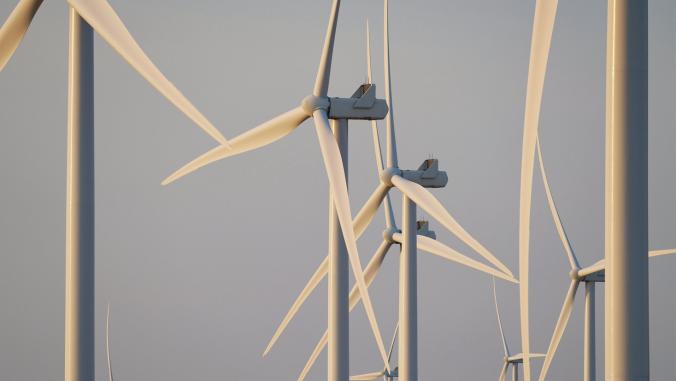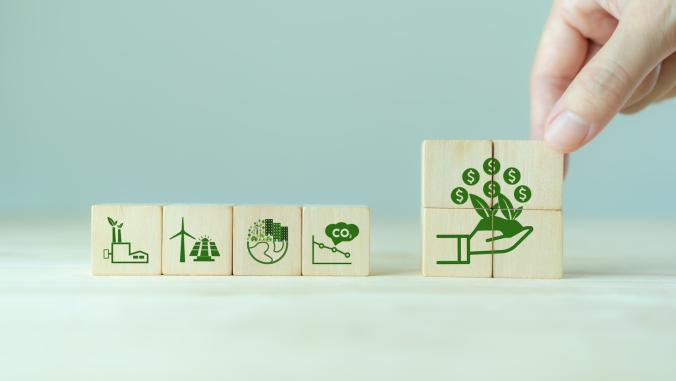How Apple is moving its supply chain toward clean energy
So far, the tech giant has helped eight companies move toward solar and wind power. The latest commitment, by Jabil, represents the largest pledge yet.

Two years ago, Apple embarked on an ambitious plan to help its biggest suppliers switch to clean power sources. As of early June, the tech giant has managed to get eight partners on board.
One, iPhone housing and parts maker Jabil, based in St. Petersburg, Florida, has committed to running the entirely of its Apple-related operations in China on renewable energy by 2018 with its huge customer’s help. That’s a sizeable commitment, representing nearly 1 billion kilowatt-hours annually.
"Jabil has always been a keen supporter of clean energy. Indeed, we are at 67 percent and striving for 90 percent this year," said Seetoh Waichong, vice general manager for GreenPoint, a Jabil company with sites in Wuxi, Chengdu and Huizhou. "It’s hard because there is a surplus of traditional energies such as hydro and thermal. … However, we also see that China Government’s plan for clean energy is also steadily increasing."
It will take a combination of direct power purchases and off-grid energy resources to make this happen, and Apple was involved in the behind-the-scenes work and meetings that will help Jabil achieve its commitment, Waichong said.
For example, Apple and Jabil met jointly with the Chengdu and Wuxi governments to shape policy changes that made it possible for Jabil to source clean power directly through power purchase agreements with local projects, primarily those involving wind farms, within the provinces where it operates facilities.
The first site where this restriction was limited was Chengdu, where Jabil has future expansion plans. While PPAs involving corporate energy buyers are becoming more common in the United States, they are still relatively rare in China because of national and provincial energy policies. Jabil is also investing in on-site solar generation at certain facilities, as appropriate.
"Jabil has for several years been driving a sustainability strategy that of consistent reduction of carbon emissions and energy consumption, as well as the positive stewardship of water resources and recycling," noted Eric Austermann, vice president of social and environmental responsibility for Jabil. "This partnership with Apple is one way we are leveraging our own commitment."
Jabil makes a number of components for Apple such as the aluminum housing for iPhones, as well as parts such the cover glass frame molding for smartphones and silicone smart battery cases.)
While Jabil’s commitment is the most aggressive so far, other Apple suppliers were quicker to get on board.
According to the tech giant’s latest update on its progress toward environmental goals, integrated circuit packaging maker Ibiden will be the first partner in Japan to power its Apple-related operations completely with renewable energy.
It is investing in at least 20 solar projects that will generate about 12 megawatts in aggregate, including one of the world’s largest floating photovoltaic plants. Glassmaker Biel Crystal Manufactory in China is also pushing for 100 percent clean power; as of the report’s publication, it had contracted to cover about half of its load.
The other suppliers planning to step up at Apple’s encouragement include glass-cover manufacturer Lens One technology, diecast specialist Catcher Technology, composts company Solvay, battery maker Sunwoda and contract manufacturer Compal.
Links in the chain
To date, Apple has installed 485 megawatts of solar and wind in six Chinese provinces, according to the recent environmental report. Commitments made by Apple in collaboration with its suppliers will influence more than 4 gigawatts of clean power installations worldwide by 2020 — including 2 gigawatts of capacity in China alone, the report estimated.
That aggregate amount represents about 30 percent of the carbon footprint associated with Apple’s manufacturing operations. (Those operations, in turn, make up about 77 percent of the tech giant’s carbon footprint.)
Apple created a Clean Energy Portal to help its supply chain share updates and give manufacturers "better technical, economic and policy data to accelerate their transition to clean energy."
Aside from helping suppliers figure out how to source electricity generated by solar and wind resources, Apple is conducting energy audits for its suppliers.
As of the end of 2016, it helped identify more than $55 million in annual energy savings, most of them recovering their return on investment within 1.4 years, according to the report. It’s training suppliers on these techniques, so that these practices can be added to operational best practices over time.
Apple was involved in the behind-the-scenes meetings that will help Jabil achieve its clean power commitment.
Apple is using green bond proceeds, among other financial programs, to help fund investments of these nature.
In mid-June, the company announced plans to borrow $1 billion to finance additional renewable energy and energy efficiency throughout its own operations, as well as those of its supply chain. One particular focus for the proceeds will be the company’s recently announced goal to create a closed-loop supply chain — one in which products are made using only renewable resources or recycle materials.
In its review of the new bond prospectus (PDF), Sustainalytics describes Apple’s plans for the proceeds as "robust and credible."
The opinion concludes: "The alignment of the 2017 Green Bond with Apple’s environmental commitments, its setting of targets and reporting on performance, in combination with the fact that Apple has not been involved in any significant environmental controversies makes Apple well positioned to issue a green bond."
Apple’s $1.5 billion green bond issued in February 2016 is still the largest issued by any U.S. technology company.





